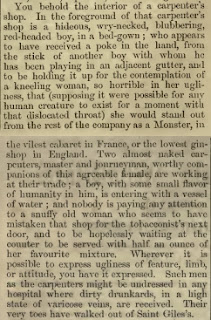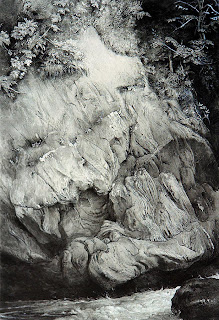Jack loved Effie and Effie loved
Jack.
Which was a problem, as Effie was
already married.
 |
| John Everett Millais c. 1854 |
Jack was John Everett Millais, a precocious talent from Jersey
who entered the Royal Academy School at the unprecedented age of eleven. In
1848, with Dante Gabriel Rossetti and William Holman Hunt, he had founded the
Pre-Raphaelite Brotherhood. His first work in the Pre-Raphaelite style Lorenzo
and Isabella had caused a sensation at the Royal Academy Exhibition of
1849, the second work, in the following year, initiated an uproar.
 |
| J E Millais - Christ in the House of His Parents - 1849-50 |
Christ in
the House of His Parents was exhibited at the Royal Academy and depicts a
boy Christ who has caught his hand on a nail, cutting his palm with blood
dripping onto his bare foot, prefiguring the marks of the nails at the
crucifixion. His mother comforts him whilst Joseph examines the wound. John the
Baptist brings a bowl of water, referring to the future baptism in the River
Jordan. The ladder in the background is Jacob’s ladder and points to Christ’s
lineage and Ascension, a triangular set-square symbolises the Trinity, a dove
on the ladder is the Holy Spirit, the sheep are the flock of the Good Shepherd.
The critics hated it. Charles Dickens, in Household Words (June 15th
1850) describes the picture thus: -
“You behold the interior of a carpenter’s shop. In the foreground of that carpenter’s shop is a hideous, wry-necked, blubbering, red-headed boy, in a bed-gown, who appears to have received a poke in the hand, from the stick of another boy with whom he has been playing in an adjacent gutter, and to be holding it up for the contemplation of a kneeling woman, so horrible in her ugliness, that (supposing it were possible for any human creature to exist for a moment with that dislocated throat) she would stand out from the rest of the company as a Monster, in the vilest cabaret in France, or the lowest ginshop in England.”
 |
| C Dickens - Household Words 1850 |
The Builder, June 1st 1850, was just as vicious, weighed in,
decrying the depiction of
“…the youthful Saviour as a red-headed Jew boy, and the sublime personage of the virgin a sore-heeled, ugly, every-day sempstress.”
Millais had depicted the Holy Family as Palestinian workers
living in a rough dwelling with dirt and wood shavings on the floor, rather
than the idealised toga-wearing Caucasians preferred by the Victorians. In a
companion piece, William Holman Hunt also used a ‘realistic’ technique in his
portrayal of an imagined incident from early Christian history, A Converted
British Family Sheltering a Christian Missionary from the Persecution of the
Druids, and was also criticised for doing so.
 |
| W H Hunt - A Converted
British Family Sheltering a Christian Missionary from the Persecution of the
Druids 1850 |
Unexpectedly, help arrived
when the distinguished art critic, John Ruskin, wrote letters to the papers
championing the Pre-Raphaelites and their intentions. Ruskin had advocated a
‘return to nature’ in his influential four volume Modern Painters
(1843-56), arguing that artists needed to make close observations of natural
forms in their works, and his views were significant in the formation of the
fledgling Brotherhood.
 |
| John Ruskin |
Ruskin became a friend and patron off the artists, and
although he did not particularly like Millais’s Christ in the House of His
Parents he was impressed by Millais’s abilities. In 1853, he invited
Millais to accompany him and his wife on a painting holiday to Scotland, where
he was to paint a portrait of the critic standing in the Scottish landscape.
 |
| J E Millais - Portrait of John Ruskin - 1854 |
At
Glenfinlas, Millais painted the background of the Ruskin portrait, with close,
almost photographic, detail of the gneiss rock formation around a waterfall,
and he added the figure the following year in the studio. Ruskin was a keen
geologist and made studies of his own of the same rocks, which rival Millais in
their attention to detail.
 |
| J Ruskin - Study of gneiss |
Millais had already used Mrs Ruskin as a model the
previous year, in his Order of Release, and their close proximity in the Scottish
Highlands led to their falling in love.
 |
| J E Millais - The Order of Release - 1852 |
Ruskin had married Euphemia Gray, a
family friend, in 1848, but it had not been a happy union – he was cold and
reserved, she was flirtatious and out-going. Effie, as she was known, left her
husband for Millais and filed for divorce on the grounds that the marriage had
not been consummated.
 |
| J E Millais - Portrait of Effie Ruskin |
Ruskin had used various excuses to explain his avoidance
– religion and hatred of children among them – before finally admitting the
real reason,
“He did not make me his Wife was because he was disgusted with my person.”
There have been various theories of just what it was that had
so disgusted Ruskin, but disgusted he undoubtedly was and the marriage remained
unconsummated. Ruskin did not contest her claims but, alarmingly, wrote, “I can
prove my virility at once.” There was a great public scandal surrounding the
case; the marriage was annulled in July 1854.
Jack Millais married his Effie
the following year and it appears that Jack was not nearly as squeamish as
John, for they went on to produce eight children. In 1885, he was granted a
baronetcy, the first British artist to receive a hereditary title.
No comments:
Post a Comment